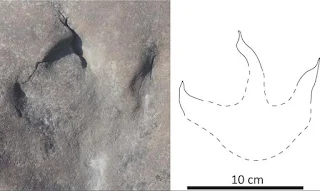Genetic secrets from 4,000-year-old teeth to illuminate the impact of changing human diets over the centuries - News & Events | Trinity College Dublin
What can you tell from two, 4000-year-old human teeth found in a limestone cave in Ireland?
Firstly, you can tell a great deal about the food their owner ate and what state their oral hygiene was in.
Secondly, you can tell how the microbiome of the human mouth has evolved over the last 4000 years.
Thirdly, you can tell that, wherever creationism's global flood took place, it missed this cave in Ireland, because had the cave been flooded, the remains of bacterial DNA in the plaque on the teeth would have been washed off, even in the unlikely event of the skeletal remains staying in the cave.
And lastly, you can tell the cave is very much older than the 10,000 years creationists believe Earth has existed for because limestone caves form slowly over millions of years due to the action of water on limestone deposits that themselves take millions of years to accumulate and be compressed into limestone.
But then the ignorant goat-herders who invented the mythical global flood knew nothing of limestone cave formation, Ireland, the people who lived there, the state of their oral hygiene, or micro-organisms for that matter, so what did you expect? Miracles?
The two teeth, from the same individual, were part of a large skeletal assemblage excavated from Killuragh Cave, County Limerick, by the late Peter Woodman of University College Cork. They have been used by researchers from Trinity College, Dublin to recover a remarkably well-preserved microbiome which shows major changes in the oral microenvironment from the Bronze Age to today.
The researchers, led by Dr Lara Cassidy, an assistant professor in Trinity’s School of Genetics and Microbiology and including scientists from the Atlantic Technological University and University of Edinburgh, have published their findings, open access in the journal Molecular Biology and Evolution and describe them in a Trinity College News release:
Researchers from Trinity have recovered remarkably preserved microbiomes from two teeth dating back 4,000 years, found in an Irish limestone cave. Genetic analyses of these microbiomes reveal major changes in the oral microenvironment from the Bronze Age to today.Technical details and background to the research is given in the team's open access paper in Molecular Biology and Evolution:
The teeth both belonged to the same male individual and also provided a snapshot of his oral health.
The study, carried out in collaboration with archaeologists from the Atlantic Technological University and University of Edinburgh, was published today in leading journal Molecular Biology and Evolution.
The authors identified several bacteria linked to gum disease and provided the first high-quality ancient genome of Streptococcus mutans, the major culprit behind tooth decay.
While S. mutans is very common in modern mouths, it is exceptionally rare in the ancient genomic record. One reason for this may be the acid-producing nature of the species. This acid decays the tooth, but also destroys DNA and stops plaque from fossilising. While most ancient oral microbiomes are retrieved from fossilised plaque, this study targeted the tooth directly.
Another reason for the scarcity of S. mutans in ancient mouths may be the lack of favorable habitats for this sugar-loving species. An uptick of dental cavities is seen in the archaeological record after the adoption of cereal agriculture thousands of years ago, but a far more dramatic increase has occurred only in the past few hundred years when sugary foods were introduced to the masses.
The sampled teeth were part of a larger skeletal assemblage excavated from Killuragh Cave, County Limerick, by the late Peter Woodman of University College Cork.
While other teeth in the cave showed advanced dental decay, no cavities were visible on the sampled teeth. However, one tooth produced an unprecedented amount of S. mutansDNA, a sign of an extreme imbalance in the oral microbial community.
The researchers also found that other streptococcal species were virtually absent from the tooth. This indicates the natural balance of the oral biofilm had been upset – mutans had outcompeted the other streptococci leading to the pre-disease state.We were very surprised to see such a large abundance of S. mutans in this 4,000-year-old tooth. It is a remarkably rare find and suggests this man was at a high risk of developing cavities right before his death.
Dr Lara Cassidy, senior author.
Smurfit Institute of Genetics
Trinity College Dublin, Dublin, Ireland.
The team also found evidence to support the "disappearing microbiome" hypothesis, which proposes modern microbiomes are less diverse than those of our ancestors. This is cause for concern, as biodiversity loss can impact human health. The two Bronze Age teeth produced highly divergent strains of Tannerella forsythia, a bacteria implicated in gum disease.
Very few full genomes from oral bacteria have been recovered prior to the Medieval era. By characterising prehistoric diversity, the authors were able to reveal dramatic changes in the oral microenvironment that have happened since.These strains from a single ancient mouth were more genetically different from one another than any pair of modern strains in our dataset, despite the modern samples deriving from Europe, Japan and the USA. This represents a major loss in diversity and one that we need to understand better.
Iseult Jackson, first author.
Smurfit Institute of Genetics
Trinity College Dublin, Dublin, Ireland.
The scientists believe this is driven by differences in the evolutionary mechanisms that shape genome diversity in these species.Over the last 750 years, a single lineage of T. forsythia has become dominant worldwide. This is the tell-tale sign of natural selection, where one strain rises rapidly in frequency due to some genetic advantage it holds over the others. T. forsythia strains from the industrial era onwards contain many new genes that help the bacteria colonise the mouth and cause disease.
S. mutans has also undergone recent lineage expansions and changes in gene content related to pathogenicity. These coincide with humanity’s mass consumption of sugar, although we did find that modern S. mutans populations have remained more diverse, with deep splits in the S. mutans evolutionary tree pre-dating the Killuragh genome.
Dr Lara Cassidy.In effect, both these disease-causing bacteria have changed dramatically from the Bronze Age to today, but it appears that very recent cultural transitions in the industrial era have had an inordinate impact.S. mutans is very adept at swapping genetic material between strains. This means an advantageous innovation can be spread across S. mutans lineages like a new piece of tech. This ability to easily share innovations may explain why this species retains many diverse lineages without one becoming dominant and replacing all the others.
Dr Lara Cassidy.
AbstractThere is a lot there for creationists to try to ignore or lie about, either to themselves or to the fools they are trying to recruit into their money-making scam.
Ancient microbial genomes can illuminate pathobiont evolution across millenia, with teeth providing a rich substrate. However, the characterization of prehistoric oral pathobiont diversity is limited. In Europe, only preagricultural genomes have been subject to phylogenetic analysis, with none compared to more recent archaeological periods. Here, we report well-preserved microbiomes from two 4,000-year-old teeth from an Irish limestone cave. These contained bacteria implicated in periodontitis, as well as Streptococcus mutans, the major cause of caries and rare in the ancient genomic record. Despite deriving from the same individual, these teeth produced divergent Tannerella forsythia genomes, indicating higher levels of strain diversity in prehistoric populations. We find evidence of microbiome dysbiosis, with a disproportionate quantity of S. mutans sequences relative to other oral streptococci. This high abundance allowed for metagenomic assembly, resulting in its first reported ancient genome. Phylogenetic analysis indicates major postmedieval population expansions for both species, highlighting the inordinate impact of recent dietary changes. In T. forsythia, this expansion is associated with the replacement of older lineages, possibly reflecting a genome-wide selective sweep. Accordingly, we see dramatic changes in T. forsythia's virulence repertoire across this period. S. mutans shows a contrasting pattern, with deeply divergent lineages persisting in modern populations. This may be due to its highly recombining nature, allowing for maintenance of diversity through selective episodes. Nonetheless, an explosion in recent coalescences and significantly shorter branch lengths separating bacteriocin-carrying strains indicate major changes in S. mutans demography and function coinciding with sugar popularization during the industrial period.
Introduction
The oral cavity is the most well-studied aspect of the ancient human microbiome, mainly due to the excellent preservation of DNA in calculus (fossilized dental plaque). However, three quarters of published ancient oral metagenomes date to within the last 2,500 years, with few full genomes available from prior to the medieval period (Fellows Yates et al. 2022). While a small number of much older preagricultural genomes have yielded important insights (Fellows Yates et al. 2021), prehistoric diversity and the impact of Holocene dietary transitions are not well characterized. Common oral taxa identified in these metagenomes include the “red complex” bacteria Tannerella forsythia, Treponema denticola, and Porphyromonas gingivalis, which are important in the development of periodontitis, a highly polymicrobial disease (Socransky et al. 1998). However, another species with a major impact on public health, Streptococcus mutans, is not preserved in calculus (Velsko et al. 2019), and has no published ancient genomes.
Streptococcus mutans is the primary cause of dental caries (Lemos et al. 2019.1), and is common in modern oral microbiomes (Achtman and Zhou 2020). Its lack of preservation in ancient microbiomes may be largely due to its acidogenic nature; acid degrades DNA and prevents plaque mineralization, which is the main substrate used for sampling (Velsko et al. 2019). Its absence may also reflect less favorable habitats for S. mutans across most of human history. Indeed, metagenomic surveys of ancient and modern microbiomes suggest that the species only became a dominant member of the oral microbiota after the medieval period due to major dietary changes, such as the popularization of sugar (Adler et al. 2013; Achtman and Zhou 2020). However, another study of modern genomes has placed more emphasis on the Neolithic transition as a driver of S. mutans proliferation (Cornejo et al. 2013.1). Caries are observed more frequently in the archaeological record after the adoption of cereal agriculture, but rise in incidence through time with a sharp increase in the Early Modern period (Bertilsson et al. 2022.1).
The relative importance of prehistoric and recent dietary transitions in the evolution of red complex bacteria is also poorly characterized. Tannerella forsythia is one of the better studied species (Warinner et al. 2014; Bravo-Lopez et al. 2020.1; Philips et al. 2020.2; Honap et al. 2023), with 55 genomes currently available (supplementary table S1, Supplementary Material online). Surveys of preagricultural (Fellows Yates et al. 2021) and European medieval diversity (Warinner et al. 2014; Philips et al. 2020.2) have shown no clear temporal trends in T. forsythia phylogenetic structure, although functional differences between ancient and modern genomes have been observed (Warinner et al. 2014; Philips et al. 2020.2). However, these data have not been coanalyzed. Here, we shed light on prehistoric oral pathobiont diversity, as well as recent changes in these species’ demography and functional repertoire, by retrieving the first ancient S. mutans genome and two distinct strains of T. forsythia from a single Early Bronze Age individual.
[…]
Conclusion
Adding a temporal dimension to pathogen genomics allows us to better estimate the timing of key evolutionary changes, as well as to capture extinct diversity. In this study, we have reconstructed ancient genomes for T. forsythia and S. mutans, which demonstrate dramatic changes in oral pathobiont population dynamics and functional composition in the last 750 years. For both species, there is a distinction between postindustrial and earlier genomes in terms of virulence factors. This is clearest in T. forsythia, where there is a temporal transect of ancient genomes: here, preindustrial genomes have a stark difference in functional repertoire compared to industrial and modern genomes. Both the host immune response and interactions with other oral microbes would be impacted by these changes. Although there is only 1 ancient S. mutans genome (KGH2-B) of sufficient quality to compare with the modern dataset, analysis in tandem with phylogenetic information implies that the modern mutacin repertoire is also a relatively recent acquisition.
Concurrent population expansions were inferred in both S. mutans and T. forsythia phylogenies in the postmedieval period, but extant S. mutans populations harbor much deeper diversity compared to T. forsythia. We hypothesize that this is related to the species’ different susceptibilities to genome-wide selective sweeps, which are more likely to occur when within-population recombination is low (Bendall et al. 2016). Streptococcus mutans is a highly recombining species (Cornejo et al. 2013.1), allowing advantageous variation to be exchanged between population members and resulting in gene-specific sweeps. In T. forsythia, genome structure is relatively stable and small-scale mutation appears to be the major driving force of diversification (Endo et al. 2015). This could lead to repeated purges in genetic heterogeneity in the population. These purges may have intensified in the past several centuries, as evidenced by the loss of diversity in modern and industrial populations, relative to prehistoric strains from the same Early Bronze Age individual. In general terms, higher biodiversity in ecosystems makes them more resilient to perturbations from environmental stressors (e.g. dietary changes and colonization by pathogenic bacteria in the case of the oral microbiome). The reduction in T. forsythia diversity over time coincides with a general loss of oral biodiversity discussed in Adler et al. (2013).
Going forward, denser sampling of ancient microbial populations may provide new insights into the evolutionary mechanisms that underlie bacterial taxon formation, adaptation and maintenance of diversity, which can vary depending on species and environment. Some species will be more amenable to dense temporal sampling than others. In particular, low levels of S. mutans preservation in the ancient DNA record may pose a significant challenge. Targeted capture of genes of interest (e.g. mutacins) as well as the core genome may provide a solution, but risks losing pangenomic diversity. In the case of T. forsythia, which is more abundant in the archaeological record, ancient metagenomic assemblies in the future may allow for the identification of hitherto unknown virulence factors in earlier strains; our analysis here is limited to the genomic content of modern T. forsythia samples, as all the ancient genomes are reference-aligned.
Overall, our findings demonstrate the utility of ancient genomes in characterizing different modes of pathobiont evolution. Temporal resolution of virulence genes can provide further insight into the shifting selection regimes of pathobionts in the human oral microbiome. In addition, these results highlight that recent cultural transitions, such as the popularization of sugar, are most relevant to understanding the shaping of present-day oral pathobiont diversity.
Iseult Jackson, Peter Woodman, Marion Dowd, Linda Fibiger, Lara M Cassidy
Ancient Genomes From Bronze Age Remains Reveal Deep Diversity and Recent Adaptive Episodes for Human Oral Pathobionts Molecular Biology and Evolution, Volume 41, Issue 3, March 2024, msae017, https://doi.org/10.1093/molbev/msae017
Copyright: © 2024 The authors/Society for Molecular Biology and Evolution.
Published by Oxford University Press. Open access.
Reprinted under a Creative Commons Attribution 4.0 International license (CC BY 4.0)
- There is the geological evidence of a limestone cave which takes millions of years to form.
- There is the evidence for evolution in the differences between the genomes of the micro-organisms found on the plaque on the surface of the teeth.
- There is the absence of any evidence for a global flood in the fact that the contents of the cave have not been submerged in water and have none of the inevitable deposits on them that would have resulted from such a flood.
- There is the evidence that there were people living in Ireland 4,000 years ago when creationists legend says they should all have been drowned in a global flood (which apparently never reached County Limerick).
- There is the evidence for evolution in both the micro-organisms themselves and also in the biodiversity of the human oral microbiome which have changed significantly as the main sources of food have changed, showing how the environment drives evolutionary change.
What Makes You So Special? From The Big Bang To You
Ten Reasons To Lose Faith: And Why You Are Better Off Without It
















































